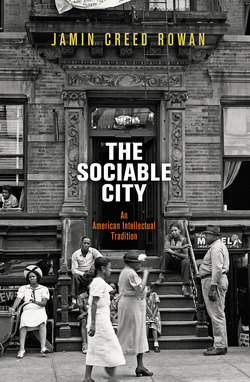The Sociable City

Реклама. ООО «ЛитРес», ИНН: 7719571260.
Оглавление
Jamin Creed Rowan. The Sociable City
Отрывок из книги
The Sociable City
Casey Nelson Blake, Series Editor
.....
Settlement residents were often aware of the thin line they walked between “doing good ‘to’ people rather than ‘with’ them,” as Addams put it, which is why they imported into their discourse of sympathy the discipline of sociology. According to settlement writers, public sympathy was a more likely relational outcome when city dwellers understood one another’s lives within larger sociological and historical contexts. Although personal interactions with other urbanites helped remind the upper-class city dweller, according to Addams, “how incorrigibly bourgeois her standards” were and how dangerous it would be to “insist” that others take up the “conventions of her own class,” settlement discourse incorporated the language and logic of the social sciences to expose more fully and rectify the social standards and class conventions that infused every urban interaction with some dimension of inequality or injustice. Addams once quipped that people “sometimes say that our charity is too scientific”; but she insisted that it would be “much more correct in our estimate if we said that it is not scientific enough.”28 Herman F. Hegner, a resident at Chicago Commons in the 1890s, initially perceived the saloonkeeper in his settlement’s neighborhood to be the “agent of immorality and crime” and wanted “nothing to do with him.” However, after gathering a “fuller knowledge of facts” about saloonkeepers through social scientific research, Hegner and his settlement colleagues “modified [their] ideas of the ethics” of the saloonkeeper and were thus able to nourish a fellow-feeling for him.29 Hegner had originally situated the saloonkeeper in a nineteenth-century Protestant narrative that defined him as a moral failure, but sociological research allowed Hegner to liberate this urban figure from that narrative and place him instead in a broader reality that he and the saloonkeeper shared—one shaped by the industrial city’s larger economic, political, and cultural forces. Sociological research put urbanites in a position to encounter one another on more common social and material ground than they might have otherwise encountered one another.
The settlement movement’s sociological studies became particularly important channels through which urbanites could expand the discourse of sympathy to account for the increasingly large number of black city dwellers with whom they shared the industrial city. Between 1880 and 1910, the black population in Chicago increased almost sevenfold, more than tripled in Manhattan, and nearly tripled in Philadelphia (making it home to the largest black community in the United States). As black citizens sought opportunities in the nation’s growing cities in the wake of Emancipation and Reconstruction, their fellow urbanites struggled to know how to interact and connect with their new neighbors. Early settlement residents found it difficult to make room for black migrants under the canopy of public sympathy. They tended to shy away from establishing settlement houses in black urban neighborhoods, which made it difficult to be in personal contact with black urbanites. Furthermore, settlement workers often failed to use sociology to gain an understanding of the larger structural conditions underpinning the black urban community; for instance, none of the essays in Hull-House Maps and Papers (1895), one of the earliest and most important sociological studies completed by early settlement workers, addresses the lives of black Chicagoans in any substantial way. When settlement workers did make an effort to understand the condition of urban blacks, they often attributed the social and economic problems their black neighbors faced to the system of slavery—an explanation that was more humane than those offered by popular theories of racial determinism, but not attentive enough to the conditions of the industrial city.30
.....